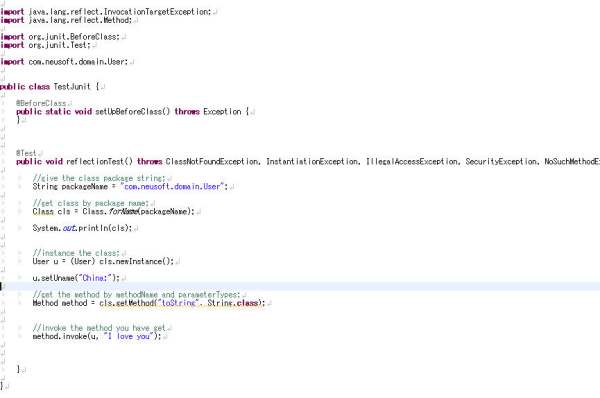JAVA反射中通过Class.forname()如何带参数的方法怎么赋值和调用呀?
Posted
tags:
篇首语:本文由小常识网(cha138.com)小编为大家整理,主要介绍了JAVA反射中通过Class.forname()如何带参数的方法怎么赋值和调用呀?相关的知识,希望对你有一定的参考价值。
没明白你说的什么意思。Class.forname()获取类。如果想调用这个类的带参数的方法:
String clsstr = "package.classname";
Class t = Class.forName(clsstr); //获取所给包名下的类
t.newInstance();//实例化获取的类
Method method = t.getMethod("methodName",String.class);//获取方法名称为methodName,参数为一个String类型的公有方法
method.invoke(t,"display");//调用此带有一个String参数的函数
上图:


import java.lang.reflect.Method;
public class InvokeMethod
public static void main(String args[])
try
//动态加载Student类
Class student = Class.forName("com.Student");
//获取Student类名称为printInfo的方法
Method method1 = student.getMethod("printInfo");
//调用printInfo方法
method1.invoke(student.newInstance());
//获取Student类名称为printInfo的方法,String.class是方法的参数类型
Method method2 = student.getMethod("printAddress",String.class);
//调用printAddress方法,其中HK是为方法传递一个参数值
method2.invoke(student.newInstance(),"hello关知红");
catch(Exception e)
e.printStackTrace();
参考技术B 类的全路径唯一确定一个类,在动态环境下,还需要制定对应的classloader。
例如
try
Class foo = Class.forName("com.foo.bar");
catch (ClassNotFoundException e)
e.printStackTrace();
参考技术C http://zhidao.baidu.com/question/7331190.html 看下这个 参考技术D public class Test
public static void main(String[] args)
try
Class<?> t = Class.forName("test.Test");
catch (ClassNotFoundException e)
// TODO Auto-generated catch block
e.printStackTrace();
在 Java 的反射中,Class.forName 和 ClassLoader 的区别
1. 解释
在java中Class.forName()和ClassLoader都可以对类进行加载。ClassLoader就是遵循双亲委派模型最终调用启动类加载器的类加载器,实现的功能是“通过一个类的全限定名来获取描述此类的二进制字节流”,获取到二进制流后放到JVM中。Class.forName()方法实际上也是调用的CLassLoader来实现的。
Class.forName(String className) 的源码如下:
1 @CallerSensitive 2 public static Class<?> forName(String className) 3 throws ClassNotFoundException { 4 Class<?> caller = Reflection.getCallerClass(); 5 return forName0(className, true, ClassLoader.getClassLoader(caller), caller); 6 }
最后调用的方法是forName0这个方法,在这个forName0方法中的第二个参数被默认设置为了true,这个参数代表是否对加载的类进行初始化,设置为true时会类进行初始化,代表会执行类中的静态代码块,以及对静态变量的赋值等操作。
也可以调用Class.forName(String name, boolean initialize,ClassLoader loader)方法来手动选择在加载类的时候是否要对类进行初始化。Class.forName(String name, boolean initialize,ClassLoader loader)的源码如下:
1 /* @param name fully qualified name of the desired class 2 * @param initialize if {@code true} the class will be initialized. 3 * See Section 12.4 of <em>The Java Language Specification</em>. 4 * @param loader class loader from which the class must be loaded 5 * @return class object representing the desired class 6 * 7 * @exception LinkageError if the linkage fails 8 * @exception ExceptionInInitializerError if the initialization provoked 9 * by this method fails 10 * @exception ClassNotFoundException if the class cannot be located by 11 * the specified class loader 12 * 13 * @see java.lang.Class#forName(String) 14 * @see java.lang.ClassLoader 15 * @since 1.2 16 */ 17 @CallerSensitive 18 public static Class<?> forName(String name, boolean initialize, 19 ClassLoader loader) 20 throws ClassNotFoundException 21 { 22 Class<?> caller = null; 23 SecurityManager sm = System.getSecurityManager(); 24 if (sm != null) { 25 // Reflective call to get caller class is only needed if a security manager 26 // is present. Avoid the overhead of making this call otherwise. 27 caller = Reflection.getCallerClass(); 28 if (sun.misc.VM.isSystemDomainLoader(loader)) { 29 ClassLoader ccl = ClassLoader.getClassLoader(caller); 30 if (!sun.misc.VM.isSystemDomainLoader(ccl)) { 31 sm.checkPermission( 32 SecurityConstants.GET_CLASSLOADER_PERMISSION); 33 } 34 } 35 } 36 return forName0(name, initialize, loader, caller); 37 }
源码中的注释只摘取了一部分,其中对参数initialize的描述是:if {@code true} the class will be initialized.意思就是说:如果参数为true,则加载的类将会被初始化。
2. 举例
一个含有静态代码块、静态变量、赋值给静态变量的静态方法的类,如下:
1 public class ClassForName { 2 3 //静态代码块 4 static { 5 System.out.println("执行了静态代码块"); 6 } 7 //静态变量 8 private static String staticFiled = staticMethod(); 9 10 //赋值静态变量的静态方法 11 public static String staticMethod(){ 12 System.out.println("执行了静态方法"); 13 return "给静态字段赋值了"; 14 } 15 }
测试代码如下:
1 public class MyTest { 2 @Test 3 public void test44(){ 4 5 try { 6 Class.forName("com.test.mytest.ClassForName"); 7 System.out.println("#########分割符(上面是Class.forName的加载过程,下面是ClassLoader的加载过程)##########"); 8 ClassLoader.getSystemClassLoader().loadClass("com.test.mytest.ClassForName"); 9 } catch (ClassNotFoundException e) { 10 e.printStackTrace(); 11 } 12 13 } 14 }
运行结果:
1 执行了静态代码块 2 执行了静态方法 3 #########分割符(上面是Class.forName的加载过程,下面是ClassLoader的加载过程)##########
根据运行结果说明 Class.forName加载类是将类进了初始化,而ClassLoader的loadClass并没有对类进行初始化,只是把类加载到了虚拟机中。
3.应用场景
在我们熟悉的Spring框架中的IOC的实现就是使用的ClassLoader。
而在我们使用JDBC时通常是使用Class.forName()方法来加载数据库连接驱动。这是因为在JDBC规范中明确要求Driver(数据库驱动)类必须向DriverManager注册自己。
以MySQL的驱动为例解释:
1 public class Driver extends NonRegisteringDriver implements java.sql.Driver { 2 // ~ Static fields/initializers 3 // --------------------------------------------- 4 5 // 6 // Register ourselves with the DriverManager 7 // 8 static { 9 try { 10 java.sql.DriverManager.registerDriver(new Driver()); 11 } catch (SQLException E) { 12 throw new RuntimeException("Can‘t register driver!"); 13 } 14 } 15 16 // ~ Constructors 17 // ----------------------------------------------------------- 18 19 /** 20 * Construct a new driver and register it with DriverManager 21 * 22 * @throws SQLException 23 * if a database error occurs. 24 */ 25 public Driver() throws SQLException { 26 // Required for Class.forName().newInstance() 27 } 28 }
我们看到Driver注册到DriverManager中的操作写在了静态代码块中,这就是为什么在写JDBC时使用Class.forName()的原因了。
以上是关于JAVA反射中通过Class.forname()如何带参数的方法怎么赋值和调用呀?的主要内容,如果未能解决你的问题,请参考以下文章